To look at a thing is very different from seeing a thing. One does not see anything until one sees its beauty.
Paying homage to those who have, by example, taught us about glamour, grace, and unerring taste, we let the people of France and Italy establish the standard of beauty by which our rooms are judged. But neither their boundless self-assurance nor their unshakable stylistic authority takes a toll on our creative energy.
Quite the contrary: It is not just that both the French and Italians have unparalleled style that can’t be copied, however hard we try. Nor is it even that we wish to broadcast what some might mistake as affluence any more than failed ambitions. Instead, it is that we pride ourselves on fashioning posh yet welcoming spaces in a beguiling way and, not incidentally, on being admired for steering away from safe harbors and skirting well-charted paths.
What better time than now, after all, to show that the American flag’s broad stripes and bright stars represent freedom, to say nothing of the indisputable right to lend a global look to any interior?
Putting our diplomatic skills to the test, we boldly fuse the unbreakable spirit of America with the heightened sophistication of Europe to imbue our houses with a style suggesting our artistry, love of life, desire for comfort and considerable beauty.
Well before the September 11, 2001, terrorist attacks on the United States, we frowned on the inexcusably opulent and shunned pretension. Wisdom also discouraged the flaunting of swank extravagances and, for that matter, thinking about the display of wealth as a passport to respectability.
Plainly, mellowed patterned rugs, chandeliers bearing dust, painted pieces having weathered years of loving wear, and towering armoires made in scattered provincial towns for the day’s minor nobility appeal to our modern sensibility. Apart from adding luster, they create the feeling of intimacy in generously proportioned spaces where seating is artfully arranged to encourage serious discussions about the predicament in the Middle East, or talk about issues that are personal.
By our own admission, we have a penchant for vintage pillows tucked snugly in the embrace of plump upholstery, and for salvaged handcrafted locks and hinges respecting the period of the house. Never mind haughty European acquisitions snapped up at the famed Marché aux Puces de Saint-Ouen, the vast weekend flea market on the outskirts of Paris, or gathered in Parma, Italy—where dealers serve as beacons of hope for making Italian rooms look Italian. Still, when it comes to that which strikes our fancy, beauty matters more to us than provenance, or the history of a piece—and quality is key.
Sweeping aside any misgivings, lest we not see anything as tempting again, we juxtapose hand-painted Italian daybeds, hand-loomed Portuguese needlepoint rugs, carved French mirrors, and Swedish corner cupboards with unevenly worn paint, not to mention discarded German trunks privy to secrets sheltered for centuries. All mix amicably with international goods already in place, including hand-blown vases from the Venetian island of Murano, heavy silver candlesticks discovered in England, maps unearthed in the Louvre museum gift shop, and folding screens from the Far East, that hark back to a love for chinoiserie, or decorative Chinese motifs.
This is not to suggest that spaces stray toward the fussy or the cluttered in the manner of Versailles. While furnishings vary widely from one bonne adresse to another—thanks largely to each having its own artistic bent—mostly we adhere to Ludwig Mies van der Rohe’s long-standing “less is more” school of design, meaning there need not be something in every corner or filling every inch.
To be sure, we long ago recognized that one liberally scaled treasure could, with few exceptions, make a stronger statement than many fragile trinkets. Yet, if anything, it is unexpected expressions of care that elicit admiring glances from those who come to call, leaving little doubt they find our attention to detail remarkable.
Even in homes stocked with all the twenty-first-century accoutrements of a new resort—counting home theaters with screens to rival the multiplex—walls are plastered in labor-intensive finishes that create time-worn backdrops for meticulously constructed window treatments duly adorned with fringe, gimp, or braid. Soft yet perfect folds tumble from iron rods hailing the light, as interlining protects draperies from fading, and more conspicuously, adds telltale weight necessary for demure billowing. Left unlined, curtains hang in a more casual fashion. For the most part, however, draperies veer away from elaborate valances, swags, and other over-the-top treatments that invariably are more suited to a crown prince’s glitzy marble palace than a gracious villa.
Meters of relaxed linen expertly woven in the textile epicenter of Lyon, France, veil the weary drawers of eighteenth-century commodes (chests with drawers), where ladies who lunch leave their Louis Vuitton, Chanel, Hermès, Prada, and Gucci handbags. Bolts of silk taffeta—hand-loomed in northern Italy—meanwhile envelop the aging shelves of antique armoires, lengthening the life of bedding by undercutting their ability to snag pricey sheets, blankets, and duvets.
For upholstery, we select jacquards, damasks, chenilles, and velvets in various weights and breathtaking hues without trading in our individuality. Natural linens with selvage borders place a mosaic of possibilities at our disposal, such as rescuing sofas and chairs from austerity with floor-sweeping bands. No matter if the idea is not quite original.
Internationally recognized oil paintings from the eighteenth, nineteenth and early twentieth century—the belle époque, or beautiful age that ended abruptly in 1914—generally are the preferred choice of those who have an obsession for art. But congenial mixes of equally impressive engravings, etchings, and lithographs also congregate on walls while interest in acquiring photography increases as well. As expected, some works of art stand propped above masonry fireplaces in true French fashion, while faded Aubusson, Savonnerie, and/or Oushak antique rugs—which not only are notoriously hard to come by but also provide more than a modicum of pleasure—swathe hardwood floors.
Prompted by Italians who flirt with bargains but remain faithful to the finest furniture and linens they can afford, we purchase what we really want, or do without when what is affordable and what is desirable appear far apart. Like generations of Europeans before us, we share a passion for quality craftsmanship graced with the patina of age but also value practicality. Then again, we possess a yen for uncommon beauty, obtainable, of course, for the right price.
The colors of the French and the Italian countryside to which we have taken a liking echo inside homes, making spaces appear larger or smaller than they are. Invariably, rich, deep hues render rooms snug and intimate, while softer, less saturated ones foster a sense of space. Subtly, color raises ceilings, lengthens walls, highlights architectural details, and diminishes structural flaws, not to mention sways our moods, arouses our senses, revives our souls, and gives us new appreciation for our homes.
Judging from the look of areas, we take at its word the old French adage, “A white wall is the fool’s paper,” mixing pigment in Venetian plaster—lately an ubiquitous favorite—and applying it exceedingly thin before waxing walls to a rich finish. Not that blinding, bright white would be our choice anyway: perceived as lacking sophistication, it fails to win approval even for door and window trim, apparently. By comparison, dove, ivory, parchment, and champagne—alluring tints borrowed from eighteenth-century silks—are still popular centuries later.
In well-tended gardens, heroic statuary shaded by trees stands guard over other noble ornaments. Antique fountains quietly spray arcs of water, moss-covered jardinières burst with foliage, and weathered park benches along with old iron tables and chairs not only present al fresco —the Italian phrase for “in the open air”—dining at its best, but also offer coveted spots for youngsters playing hide-and-seek away from streets and pebble-lined driveways.
To our delight, we have mastered the fabled French way of melding the past with the present so that each is seen in the best possible light, as well as the uncanny Italian knack of linking rooms effortlessly with patterns and palettes without detracting from the furnishings or objets d’art. But sometime late in the twentieth century, a new confidence emerged among us, helping us envision a chic way of in-town living that was no longer in awe of Europe but inimitably American, replete with possibilities as regal as any abroad.
Paying little heed to the fleeting decorating trend of the moment—knowing, of course, any craze could become passé quickly—or even proclaiming undying affection for the single-minded style of a long-dead king to show the same restraint, we grew to be above all that. With keen eyes and a view of the world broadened beyond America, we set out on a foreign course, bulging with treasures to carefully consider.
Politely put, nowadays, a single period and genre befitting a Parisian flat appears almost defiantly dated, however well crafted.
Amid strong, stately architecture with requisite soaring ceilings, imposing stone fireplaces, generously chiseled moldings, oak parquet de Versailles floors, and boiserie, or exquisitely carved paneling, it is disparate furnishings, all with their own centuries-long résumés, that produce a distinctive look.
Indeed, our forte is putting a cosmopolitan spin on settings sated with riches dispatched from assorted corners of the world—sometimes without leaving the States—for they are suggestive of our personalities and forward-looking way of life.
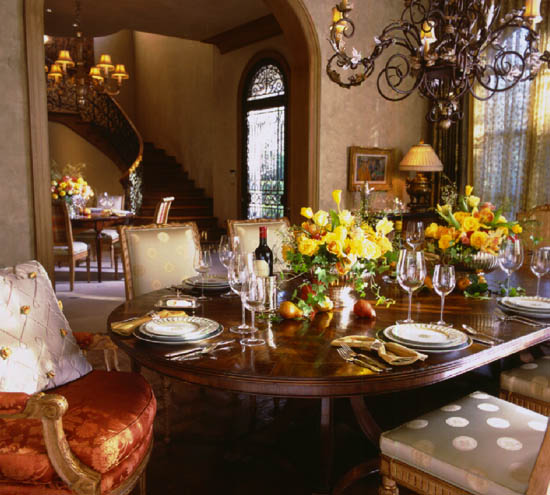
In a villa with soaring ceilings, massive walls, lavish architectural detailing, and extraordinary art, guests might well imagine themselves at a dinner honoring visiting dignitaries. The table is set with Baccarat crystal, Bernardaud china, and flatware from the Italian house of Buccellati, known the world over. The painted and gilded dining chairs are by Nancy Corzine.
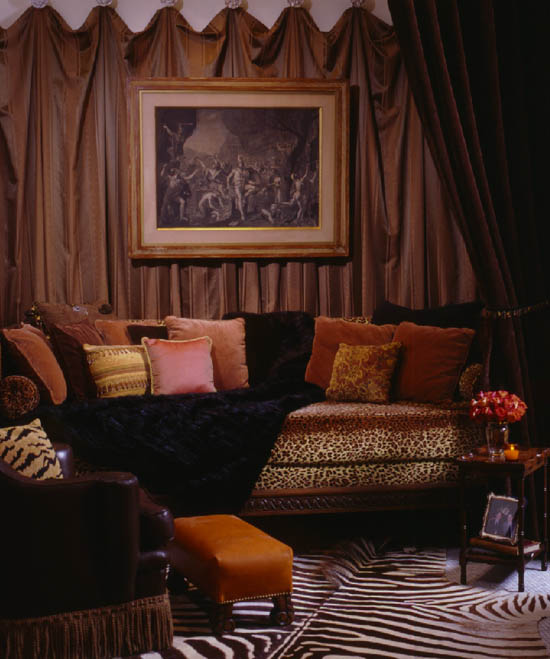
A niche in the master bathroom owes its playfulness to the leopard lounging on the daybed. Though zebra, giraffe, and cheetah prints take refuge on both sides of the Atlantic, it is leopard that the French think is très cool. The Stroheim & Romann curtain also helps capture a look that is chic. Fabric from Kravet camouflages the wall.
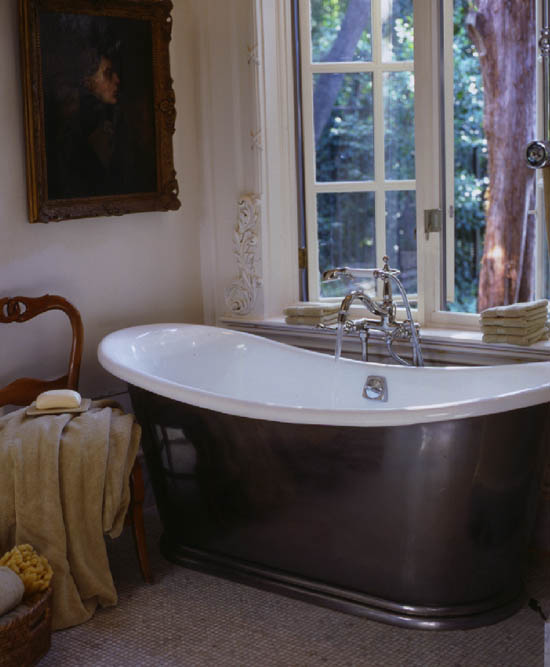
What finer place to wash away the cares of the day than in a French Empire tub? It is, of course, all-important fixtures and fittings that conspire to make a world of difference in any bathroom. The freestanding tub dating from the nineteenth century springs from Water Monopoly in London, England, restorers of antique bathroom fixtures.
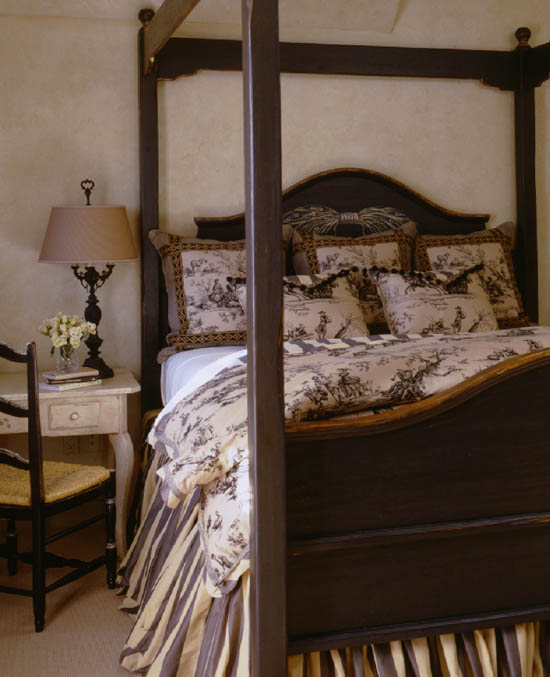
Summing up all that is French, a bedroom in le style Provençal might very well be set in a farmhouse, or mas, in the South of France. Both the toile and stripe are from Schumacher. In its former life the lamp was an old oil lantern; Van Horn & Hayward in Houston wired it and then topped it with a custom shade.
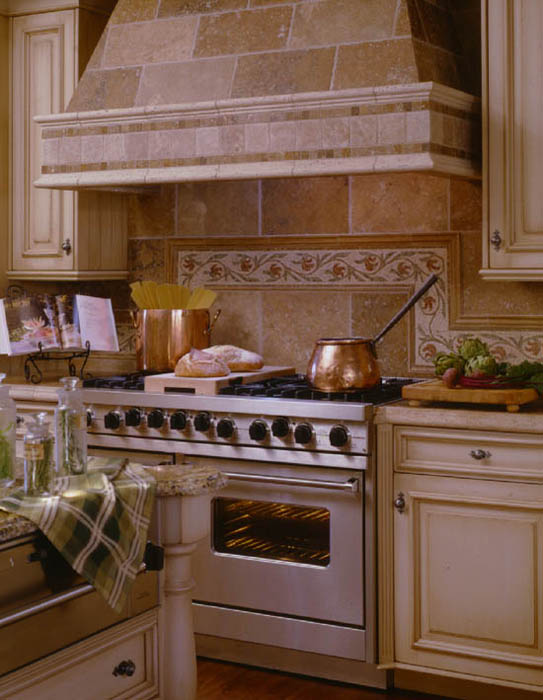
European antiques hugging countertops deliver generous helpings of charm to a St. Louis, Missouri, kitchen suited to the impeccable taste of a cook who revels in creating innovative dishes that are as pleasing to the eye as to the palate.
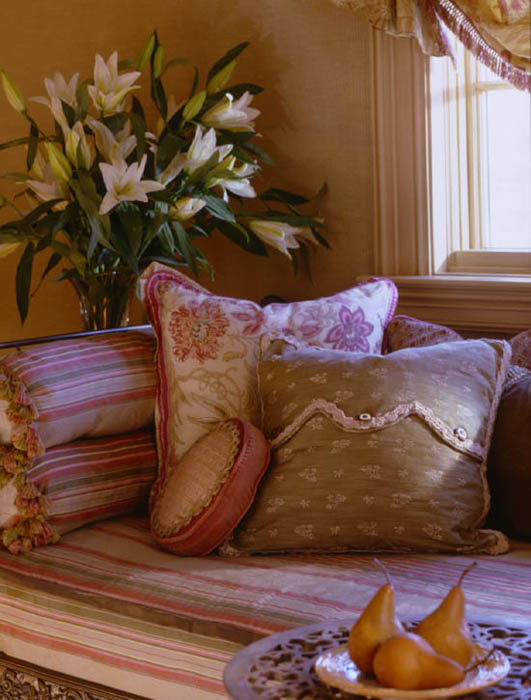
An antique daybed with lavish scrollwork is outfitted in vintage fabrics from a variety of places. Daybeds—resembling rustic cot-sized beds with footboards on both ends—first appeared in American homes at the beginning of the twentieth century. The table holding pears is an antique.
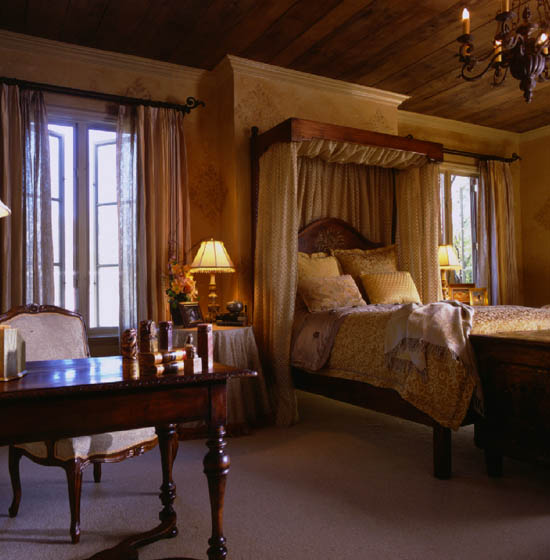
The belief that guest quarters should be no less stylish than the master bedroom opens the door to a room that is not merely a place to sleep. Swathes of beautiful fabrics add drama to the Su-Su III carriage canopy from The Farmhouse Collection; lamps on night tables are by Festoné. At the foot of the bed rests a vintage trunk from Ireland that not only reminds us that “getting there” was once half the fun, but also doubles as a luggage stand. The French writing desk dates from 1880. Dallasite Jane Shook artfully stenciled the walls.
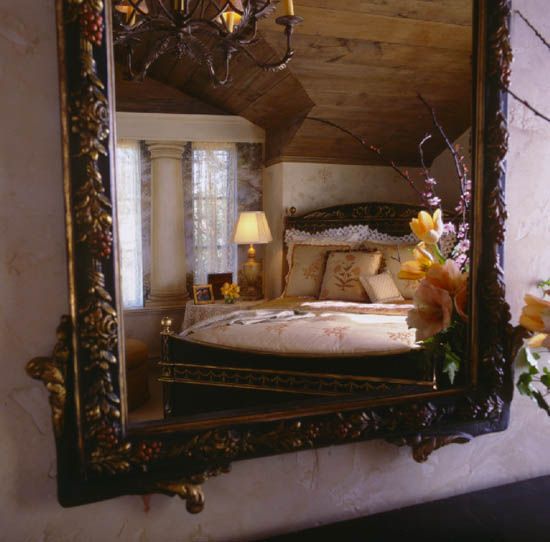
Affection for France travels into another guest room where a visiting dignitary might rest easy. Making a world of difference are a bed from Amy Howard and a chandelier by Murray’s Iron Works. The marble-topped chest from Inessa Stewart Antiques and an antique mirror from the Whimsey Shoppe, both in Dallas, add to the allure.

Light dances under the arches framing a villa hall.

Owning a hand-painted Italian piece links us to the Italian people, not to mention letting us share that which makes their life sweeter. A handsome circa-1860 chest, whose timeworn finish and exuberant carving make it easy to distinguish from later pieces, occupies a prime spot in an entrance hall. Furniture painting began in Italy around 1300 and has long been a point of national pride.
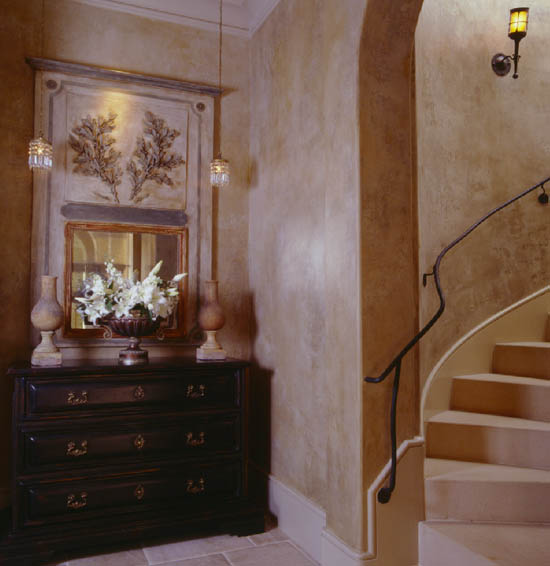
Gracefully curved stairs sculpted out of French limestone lead from a first-floor hall to the piano nobile . The French chest, circa 1860, was found at Brian Stringer Antiques, while the trumeau, dated 1885, is from Area; both companies are in Houston. The whimsical crystal and bronze light fixtures came from Suzanne Golden Antiques in New York City.

In a niche outside the powder room sits a cabinet filled with everything a guest might need, including a gorgeous Sherle Wagner sink. Towels are from Waterworks; the accessories are from Lovers Lane Antiques, Dallas.
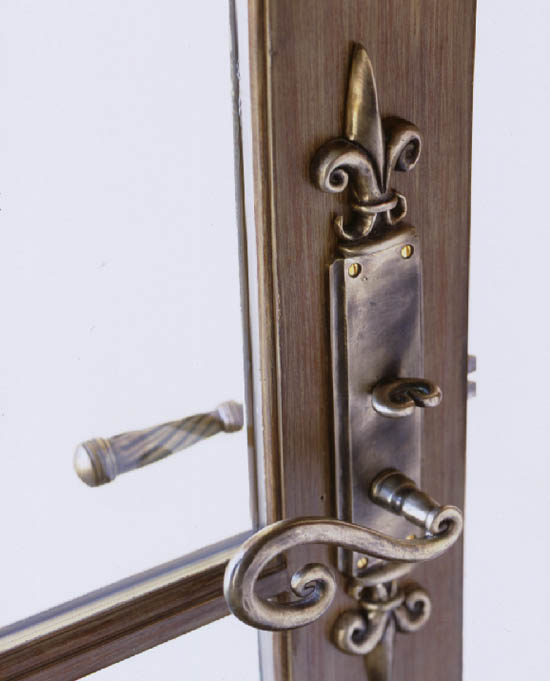
Pewter hardware reminds us of a simpler way of life a century ago. Artisan Brad Oldham designs and manufactures French-style knobs, levers, pulls and elevator dials that are used in homes from California to Texas to New York.

The French have long inspired American chefs, even if some of us have not yet matched their talents. But the splendor of Stateside kitchens often puts those abroad to shame. Here, innovatively designed, silver-plated copper cabinets—custom built by the Lonestar Range Hood Company, Houston—add to the glamour of a fine French home. Open shelves put necessities within easy reach, while the Jenn-Air commercial range bespeaks good taste.
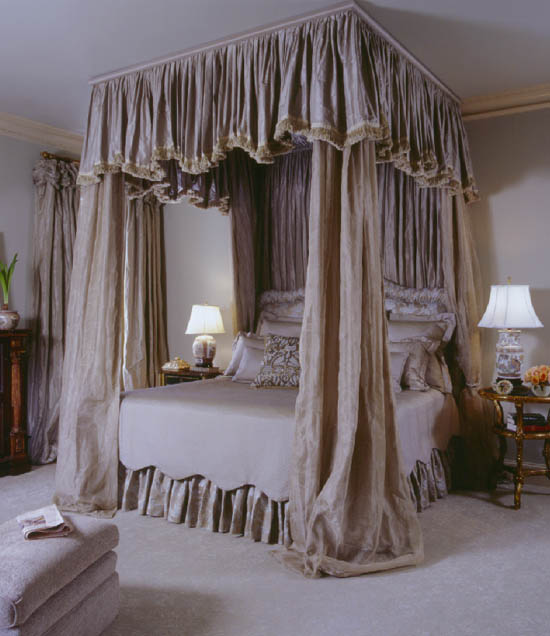
Much like the French, we lavish extraordinary attention on our beds with sensuous linens, goose-down duvets, and layers of pillows. Although bed hangings no longer must fend off drafts in poorly heated rooms, they still summon images of splendor, especially when Rogers & Goffigon Ltd. and Brunschwig & Fils textiles are fabricated by Gulf Draperies in Houston. In the era of Louis XV, each bedroom had its own garde-robe, or dressing room, and a boudoir that offered a quiet spot to get away alone or, if one so chose, to receive and entertain guests.
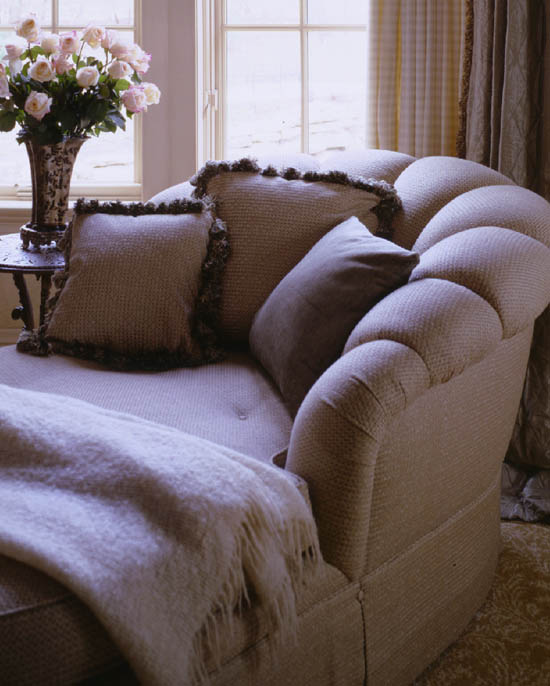
Restoring peace of mind comes easy in the comfort of this sumptuous Summer Hill chaise. In eighteenth-century France the chaise was neither a settee nor a daybed but somewhere in between—an elongated, low bergère with a feather mattress, cushions, and rounded cylindrical pillows at each end.

With its classic, aristocratic good looks, a gracious room begs for a coterie of close friends eager to share interests while basking in the beauty of glistening silver, a Dennis & Leen chandelier, and breathtaking de Gournay silk wallcovering produced in England. The dining room was not commonplace in American homes until the mid-nineteenth century.
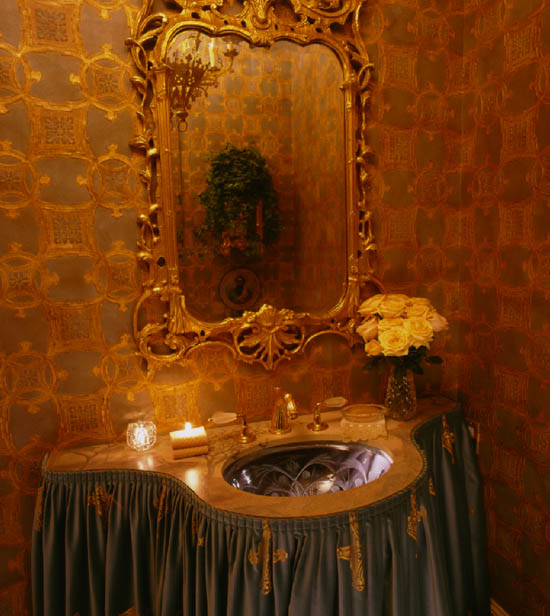
An appreciation for the old, the unusual, the unexpected, and the unique lead the way to a powder room that is classically French. In the fourteenth century, it was believed that mirrors held magic powers; to keep production methods secret, the Venetians threatened imprisonment and death; yet, by 1665 French mirrors began outshining those from Venice. The Josephine Zapata wallcovering is available through the Gerald Hargett Showroom, Houston. The frosted-glass sink is by Elegant Additions, also in Houston.

It is only natural for haute couture curtains fit for a Paris runway or the cover of a major fashion magazine to catch the eye. Finely pleated silk shantung from Shalimar Creations, Houston, is accompanied by tassel-fringed edging from Kenneth Meyer, San Francisco. The Nile chair is by Michael Taylor Designs, Los Angeles, while the antique pillow was found at Lewis & Maese, Houston. Neiman Marcus stores carry the Jay Strongwater picture frames shown here.
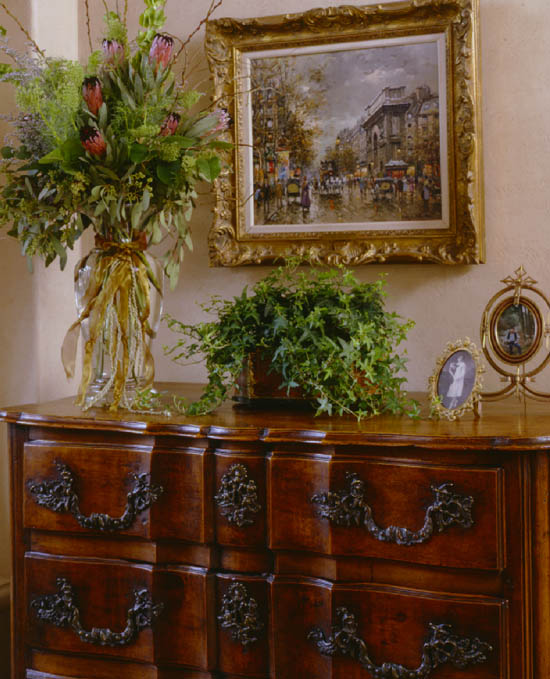
At the far end of the great room stands an early-eighteenth-century Louis XV walnut commode with impressive bronze mounts. It has a place of honor beneath Porte St. Martin by Frenchman Antoine Blanchard (1910–88), who found the streets of Paris endlessly fascinating.
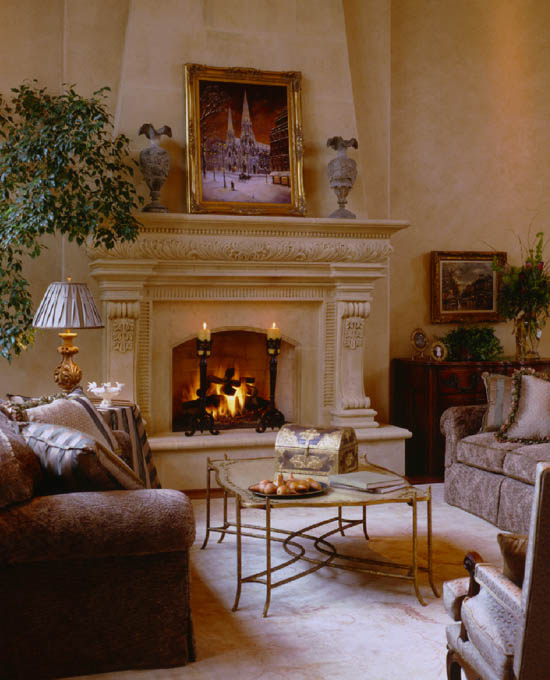
Majestically scaled plump sofas—covered in Christopher Norman chenille—and a subtle palette imparts a look that is both striking and chic. But it is the masterfully carved stone chimneypiece that commands attention. On its mantel rest nineteenth-century French urns. A Dennis & Leen shaped chinoiserie tray table hovers between the sofas.
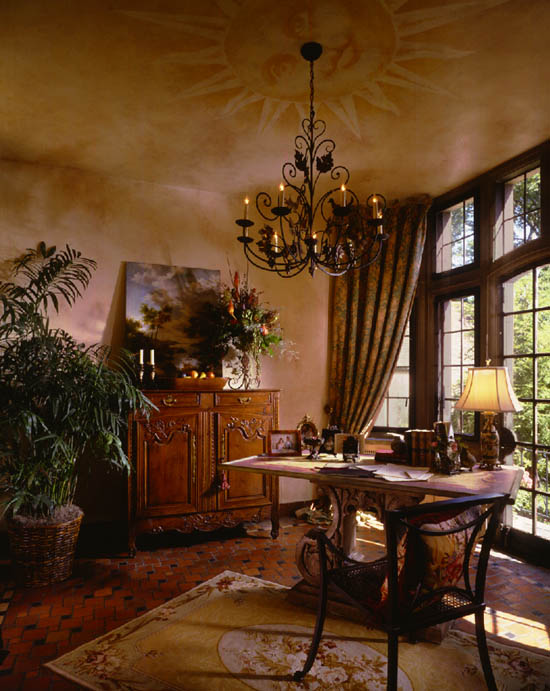
Hand-painted sundials are often seen on the sides of stately manor houses, or bastides, as they are called in France. But here, the sun itself—painted by David Manning of Evanston, Illinois—shines down on a spacious morning room. Making it tempting to disagree with the old adage “There’s nothing new under the sun” is a chandelier from Ironware International, which casts soft light. The French buffet dating from the nineteenth century is from Galleria, in Chicago.
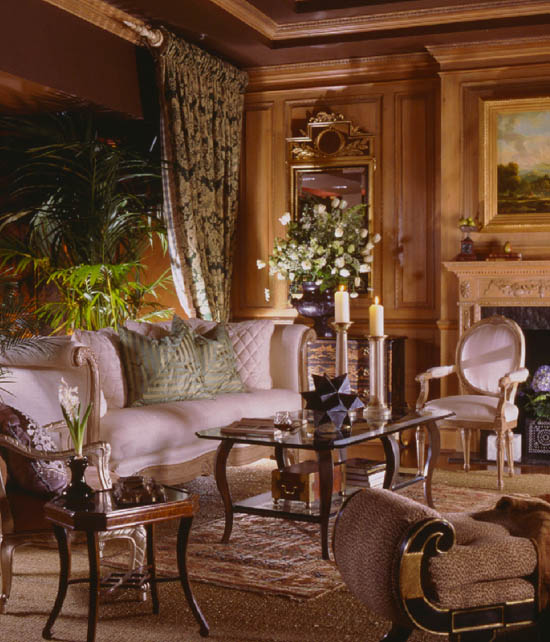
The past and the present meet in a French drawing room. The fireplace fender, vase, and painting are all antique. Paneling dispatched from Oxfordshire, England, serves as the backdrop for a finely crafted chinoiserie chest from John Widdicomb Furniture. The appealing area rug arrived via Minasian Rugs, a favorite destination for Janie Petkus and other Chicago designers. The Marge Carson settee wears Beacon Hill fabric.
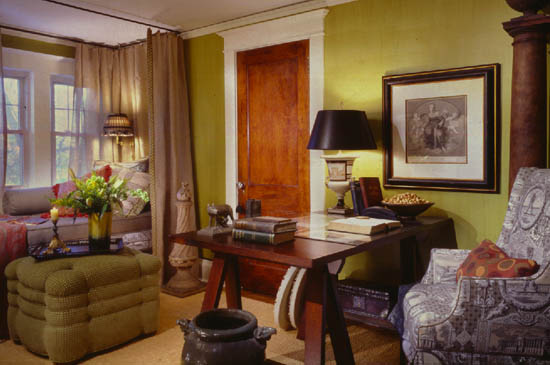
Capturing the signature artistry for which the French are known is an impeccably furnished retreat. Everything—from the iron daybed and swing arm lamp to the classical toile —speaks of Chicago designer Tony Stavish’s attention to detail.
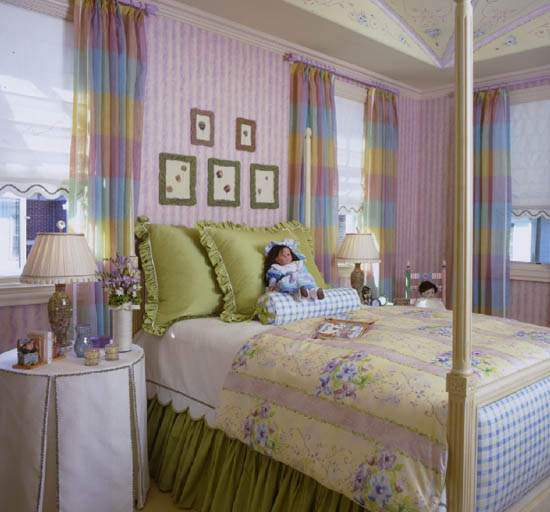
A young girl’s bedroom is a world unto itself—fashioned no less stylishly than other rooms in the house. Charming Anna French wallcovering sets the palette, while trims and scalloping make for an even prettier place. The white piqué —French for quilted—gracing the table skirt, shades, and blanket cover is by Summer Hill. Accessories are from Room Service, Dallas.
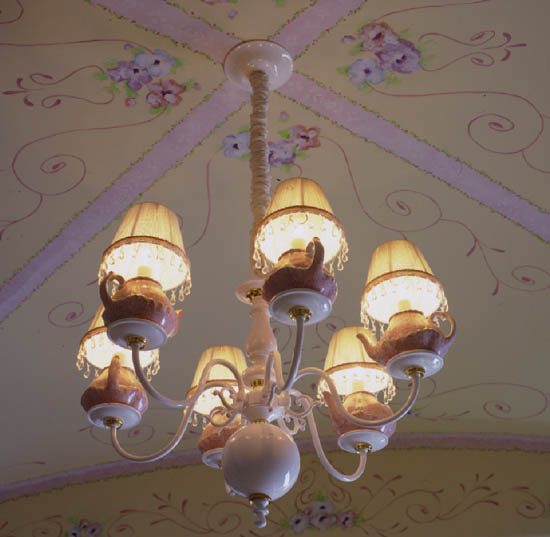
A chandelier gives this room added pizzazz.
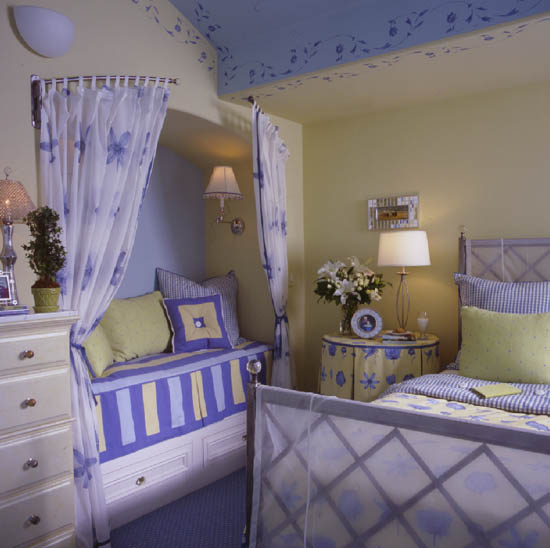
“. . . Such stuff as dreams are made on,” Shakespeare once said, as if he looked around this young girl’s room. The chic and comfy bedding tucked into this niche is also the perfect place to curl up with a book. The sheer is by Ralph Lauren. Most other fabrics are from Boussac of France.
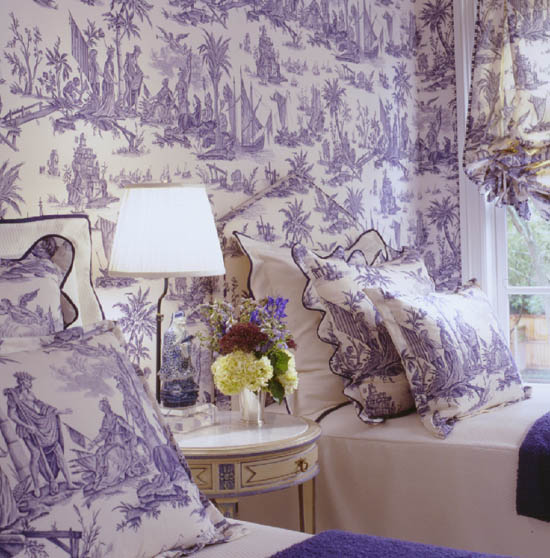
The French joie de vivre can be gleaned from guest beds wearing a Quadrille toile. Toiles de Jouy originated in the mid-eighteenth century at the Oberkampf factory in the French town of Jouy-en-Josas, near Versailles. Monochrome prints, usually red or blue on white cotton or muslin ground, depicted pastoral and mythological scenes. Later, toiles celebrated current events.